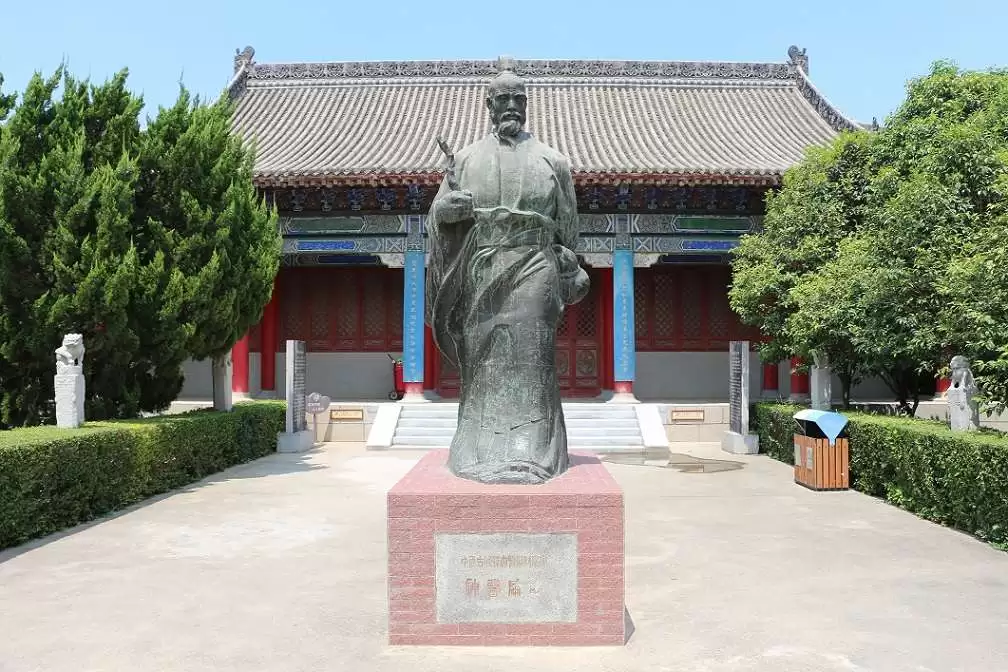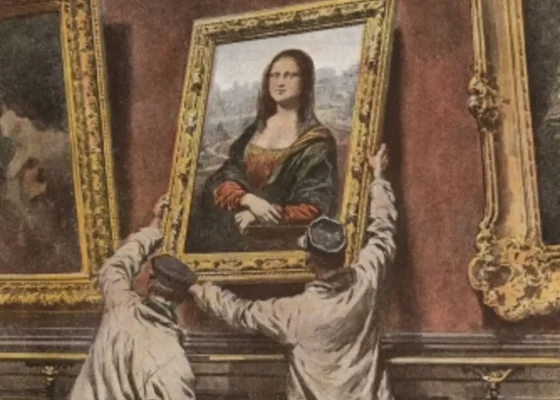
By Zhihui Zou
During the Warring States Period (c. 471-221 BCE), Chinese society was in constant conflict, and the people lived a turbulent lifestyle. During this chaotic time in history, a master medical physician was born by the name of Qin Yueren. According to Shiji, better known as the Records of the Grand Historian written by Sima Qian and first published in c. 91 BCE, Qin revolutionized traditional Chinese medicine, specifically in the areas of pulse-taking and acupuncture therapy. Some documents even suggest that Qin was the first person to practice anesthesia in China. Although his given name was Qin Yueren, because of his mastery of medicine and medical treatment, he was given the title of Bian Que, translated as “master doctor.”
Bian Que lived during the 4th century BCE in the State of Qi, one of the many kingdoms involved in the Warring States conflict. Before becoming a physician, Bian Que worked as an inn keeper for more than a decade. During this time, Bian Que was known for treating his customers with the utmost respect and kindness, creating an environment of temporary tranquility for travelers during the unstable and warring time.
One of Bian Que’s customers was an elderly man named Chang Sangjun, a highly-skilled physician who possessed a secret medical manual. Chang was a frequent guest to Bian Que’s inn. While other inns and other staff served Chang half-heartedly, Que treated Chang with much kindness. Bian Que did not know that Chang was a medical master and could only tell that Chang was an unusual guest through his careful and calm demeanor. For years, Bian Que welcomed Chang warmly when he visited the inn. According to the Records of the Grand Historian, Bian Que’s kindness and dedication to his work moved Chang, and Chang taught Bian Que all of the medical formulas he knew and later gifted him the medical manual. Bian Que’s kindness to his guests led him to leave his inn and become a traveling doctor, treating patients in both his home state of Qi and the neighboring state of Zhao.
Through Chang’s secret teaching, Bian Que created a method of Four-Step Diagnosis: Looking, Listening, Inquiring, and Taking. He would first look at the external appearances of the patient, then listen to the patient describing the illness, ask questions next, and end the diagnosis by taking the patient’s pulse. Bian Que was especially famous for taking the pulse of his patients, and in doing so, single-handedly pioneered a new era in Chinese medicine. His Four-Step Diagnosis practice hence spread among Chinese medicine practitioners, and they all learned Bian Quo’s pulse-taking practice.
Bian Que became famous after meeting Duke Huan of the State of Qi. Just after seeing the duke, Bian Que diagnosed him with a disease that he was only showing the slightest symptoms of. Bian Que correctly predicted that if the duke were to let the disease spread further in his body, it would soon be untreatable. Even after Bian Que visited the duke multiple times to address the disease, the duke dismissed Bian Que’s diagnosis, which eventually led to the duke dying of the illness.
Perhaps Bian Que’s most magical tale is him “reviving” the prince of the State of Guo. When visiting Guo, Bian Que was told that the king was preparing a proper mourning for what he thought would be his deceased prince. After hearing about the prince’s symptoms, Bian Que decided to visit the prince and believed that he was only in a deep coma. Using his expertise in acupuncture, Bian Que set a single needle into the prince’s head and “revived” him. Bian Que then fixed herbal medicines and helped the prince to fully recover in only twenty days.
Bian Que’s magical illness treatment earned him the name of Divine Doctor and he is still being celebrated today. His medical knowledge and belief helped Chinese medicine to step forward in practicality, and laid a solid foundation for the future of Traditional Chinese Medicine.









Cancel anytime


Using our website
You may use the The Middle Land website subject to the Terms and Conditions set out on this page. Visit this page regularly to check the latest Terms and Conditions. Access and use of this site constitutes your acceptance of the Terms and Conditions in-force at the time of use.
Intellectual property
Names, images and logos displayed on this site that identify The Middle Land are the intellectual property of New San Cai Inc. Copying any of this material is not permitted without prior written approval from the owner of the relevant intellectual property rights.
Requests for such approval should be directed to the competition committee.
Please provide details of your intended use of the relevant material and include your contact details including name, address, telephone number, fax number and email.
Linking policy
You do not have to ask permission to link directly to pages hosted on this website. However, we do not permit our pages to be loaded directly into frames on your website. Our pages must load into the user’s entire window.
The Middle Land is not responsible for the contents or reliability of any site to which it is hyperlinked and does not necessarily endorse the views expressed within them. Linking to or from this site should not be taken as endorsement of any kind. We cannot guarantee that these links will work all the time and have no control over the availability of the linked pages.
Submissions
All information, data, text, graphics or any other materials whatsoever uploaded or transmitted by you is your sole responsibility. This means that you are entirely responsible for all content you upload, post, email or otherwise transmit to the The Middle Land website.
Virus protection
We make every effort to check and test material at all stages of production. It is always recommended to run an anti-virus program on all material downloaded from the Internet. We cannot accept any responsibility for any loss, disruption or damage to your data or computer system, which may occur while using material derived from this website.
Disclaimer
The website is provided ‘as is’, without any representation or endorsement made, and without warranty of any kind whether express or implied.
Your use of any information or materials on this website is entirely at your own risk, for which we shall not be liable. It is your responsibility to ensure any products, services or information available through this website meet your specific requirements.
We do not warrant the operation of this site will be uninterrupted or error free, that defects will be corrected, or that this site or the server that makes it available are free of viruses or represent the full functionality, accuracy and reliability of the materials. In no event will we be liable for any loss or damage including, without limitation, loss of profits, indirect or consequential loss or damage, or any loss or damages whatsoever arising from the use, or loss of data, arising out of – or in connection with – the use of this website.
Last Updated: September 11, 2024
New San Cai Inc. (hereinafter “The Middle Land,” “we,” “us,” or “our”) owns and operates www.themiddleland.com, its affiliated websites and applications (our “Sites”), and provides related products, services, newsletters, and other offerings (together with the Sites, our “Services”) to art lovers and visitors around the world.
This Privacy Policy (the “Policy”) is intended to provide you with information on how we collect, use, and share your personal data. We process personal data from visitors of our Sites, users of our Services, readers or bloggers (collectively, “you” or “your”). Personal data is any information about you. This Policy also describes your choices regarding use, access, and correction of your personal information.
If after reading this Policy you have additional questions or would like further information, please email at middleland@protonmail.com.
PERSONAL DATA WE COLLECT AND HOW WE USE IT
We collect and process personal data only for lawful reasons, such as our legitimate business interests, your consent, or to fulfill our legal or contractual obligations.
Information You Provide to Us
Most of the information Join Talents collects is provided by you voluntarily while using our Services. We do not request highly sensitive data, such as health or medical information, racial or ethnic origin, political opinions, religious or philosophical beliefs, trade union membership, etc. and we ask that you refrain from sending us any such information.
Here are the types of personal data that you voluntarily provide to us:
As a registered users or customers, you may ask us to review or retrieve emails sent to your business. We will access these emails to provide these services for you.
We use the personal data you provide to us for the following business purposes:
Information Obtained from Third-Party Sources
We collect and publish biographical and other information about users, which we use to promote the articles and our bloggers who use our sites. If you provide personal information about others, or if others give us your information, we will only use that information for the specific reason for which it was provided.
Information We Collect by Automated Means
Log Files
The site uses your IP address to help diagnose server problems, and to administer our website. We use your IP addresses to analyze trends and gather broad demographic information for aggregate use.
Every time you access our Site, some data is temporarily stored and processed in a log file, such as your IP addresses, the browser types, the operating systems, the recalled page, or the date and time of the recall. This data is only evaluated for statistical purposes, such as to help us diagnose problems with our servers, to administer our sites, or to improve our Services.
Do Not Track
Your browser or device may include “Do Not Track” functionality. Our information collection and disclosure practices, and the choices that we provide to customers, will continue to operate as described in this Privacy Policy, whether or not a “Do Not Track” signal is received.
HOW WE SHARE YOUR INFORMATION
We may share your personal data with third parties only in the ways that are described in this Privacy Policy. We do not sell, rent, or lease your personal data to third parties, and We does not transfer your personal data to third parties for their direct marketing purposes.
We may share your personal data with third parties as follows:
There may be other instances where we share your personal data with third parties based on your consent.
HOW WE STORE AND SECURE YOUR INFORMATION
We retain your information for as long as your account is active or as needed to provide you Services. If you wish to cancel your account, please contact us middleland@protonmail.com. We will retain and use your personal data as necessary to comply with legal obligations, resolve disputes, and enforce our agreements.
All you and our data are stored in the server in the United States, we do not sales or transfer your personal data to the third party. All information you provide is stored on a secure server, and we generally accepted industry standards to protect the personal data we process both during transmission and once received.
YOUR RIGHTS/OPT OUT
You may correct, update, amend, delete/remove, or deactivate your account and personal data by making the change on your Blog on www.themiddleland.com or by emailing middleland@protonmail.com. We will respond to your request within a reasonable timeframe.
You may choose to stop receiving Join Talents newsletters or marketing emails at any time by following the unsubscribe instructions included in those communications, or you can email us at middleland@protonmail.com
LINKS TO OTHER WEBSITES
The Middle Land include links to other websites whose privacy practices may differ from that of ours. If you submit personal data to any of those sites, your information is governed by their privacy statements. We encourage you to carefully read the Privacy Policy of any website you visit.
NOTE TO PARENTS OR GUARDIANS
Our Services are not intended for use by children, and we do not knowingly or intentionally solicit data from or market to children under the age of 18. We reserve the right to delete the child’s information and the child’s registration on the Sites.
PRIVACY POLICY CHANGES
We may update this Privacy Policy to reflect changes to our personal data processing practices. If any material changes are made, we will notify you on the Sites prior to the change becoming effective. You are encouraged to periodically review this Policy.
HOW TO CONTACT US
If you have any questions about our Privacy Policy, please email middleland@protonmail.com
The Michelin brothers created the guide, which included information like maps, car mechanics listings, hotels and petrol stations across France to spur demand.
The guide began to award stars to fine dining restaurants in 1926.
At first, they offered just one star, the concept was expanded in 1931 to include one, two and three stars. One star establishments represent a “very good restaurant in its category”. Two honour “excellent cooking, worth a detour” and three reward “exceptional cuisine, worth a
You must be logged in to post a comment.
Thank you for your participation,
please Log in or Sign up to Vote

123Sign in to your account
One Response